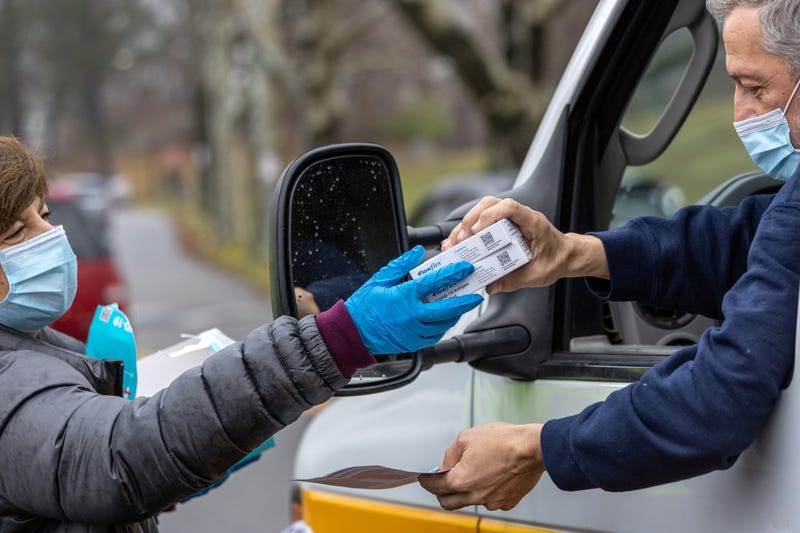
Buffalo, N.Y. (WBEN) - With the continual rise of COVID-19 case numbers, especially with the Omicron variant making its presence known over the last several weeks, the demand for COVID-19 testing has been reaching all-time highs in New York State and Erie County.

With the Christmas and New Year's holiday, people flocked to pharmacies and other health care stores to clean the shelves of at-home COVID-19 testing kits. People also lined up at testing facilities to make sure of their health status before visiting with family, friends and other loved ones for the holidays.
Over the past several days, towns across Erie County have been distributing free at-home COVID-19 testing kits to residents, as part of a statewide initiative to make at-home testing kits available to more households.
As a result of the rapid increase in testing, COVID-19 case numbers also saw a substantial increase. Of the data that has been tracked over the last seven days, Erie County has seen more than 20,000 new cases of COVID-19, including 2,534 new cases on Monday.
While last week saw some of the highest positivity rates of COVID-19 in Erie County since the start of the pandemic, the case numbers over the past few days have taken a dip on the downward trend.
Statewide, Gov. Kathy Hochul said Tuesday that while cases are still high, the rate of increase with the case numbers are slowing down, which might indicate the state be "cresting over that peak."
While the hope remains that the state has hit its peak with this wave of the Omicron variant, the recent trends for testing could also indicate some positive news.
"We have expanded our testing capabilities recently, however, looking at the lines of certain testing centers, perhaps we've already peaked, in terms of demand," said Dr. Thomas Russo from the Jacobs School of Medicine and Biomedical Sciences at the University at Buffalo. "I'm hoping that's the case, and I'm hoping that's reflecting the fact that we're maybe plateauing, in terms of the number of infections here in Western New York. We'll have to see how things play out in the week when I think we'll have a better sense of where we're at. I do think we have enough testing capabilities here to be able to handle the demand."
Testing has become important as a way to combat the spread of COVID-19, especially with how contagious the Omicron variant has been reported to be. Dr. Russo says testing is key to help people understand their health situation in order best protect yourself and others you come in close contact with on a daily basis.
"You want to know if you're infected for your personal health, so you can reach out to your healthcare provider to give you advice on how to monitor symptoms and if you're eligible for out-patient treatment. It's also important to know if you're positive so you can isolate, protect those in your household and protect those you interact with as well," Dr. Russo said. "Testing obviously has an important role, in terms of both management of individuals that are infected and trying to help break the transmission chain by minimizing subsequent exposure and putting others at risk of getting infected."
With the introduction of at-home testing kits a while back and the recent distribution of these kits to residents, this should only help people be able to get a better picture whether or not they are in the clear, or they need to quarantine and steer clear of others.
But how reliable and accurate are these at-home kits that people are using?
"The reported sensitivity is in the order of the mid-80% range," Dr. Russo said. "There has been some discussion that they may be a little less sensitive with Omicron than they were with Delta and some of the earlier variants. I think people just need to realize the home tests aren't as sensitive as the PCR tests and interpret them within that context. If they really have symptoms, they think they have a likelihood they have COVID and the home tests are negative, don't assume that you don't have COVID.
"They're helpful, but they're not the [be-all and end-all], and as long as you know the limitations of these home tests and interpret it within that context, I think you'll be OK."
While these at-home tests certainly plays an important role to help people better combat COVID-19, Dr. Russo points out it's critical that people follow the instructions and do the tests properly. If they don't, the result of the test is going to be unreliable.
Over the course of the pandemic, it has been stressed both at the county level and the state level that it is important for hospitalization numbers to remain at a manageable level in order to avoid capacity issues in hospitals and not to overwhelm the staff on-hand.
With such a focus being placed on hospitalization numbers to determine the severity of COVID-19 surges, especially with the Omicron, how much of a focus still needs to be on case numbers, especially since there are some people that don't even report they've tested positive?
"While in the midst of this Omicron wave, case numbers help us to determine when we're going to hit our peak, when we're going to be on the back side of that peak, which will help us to gauge the relative risk and the likelihood when you're interacting with individuals that someone could be infectious," Dr. Russo explained.
"Hospitalization numbers used to be a great marker for what we're most concerned about, which is severe disease. However, now since many people have been vaccinated, they are being admitted to hospitals with no symptoms and turn out to be positive, since our vaccines are not perfect. Many individuals are getting mild infections or asymptomatic infections. So our hospitalization numbers don't actually accurately assess the true burden of hospitalizations due to COVID. I think in Erie County right now, about a third of the individuals that are in hospitals with a diagnosis of COVID have been incidentally diagnosed."
So what statistics should be looked at and monitored closely associated with COVID-19 going forward?
"The numbers that I think are going to be critically important for us are hospital capacity numbers, because when we hit capacity and exceed that, that's when outcomes are going to be worse when our healthcare systems are over-stressed," Dr. Russo said. "Unfortunately the other important numbers are deaths. Deaths have been increasing here in Erie County, New York State and in the country over the last week-plus or so. The deaths will be the ultimate measure of how well we handle, and the degree of damage done by this Omicron wave."
As we continue to wait and view the trends with COVID-19 case numbers and hospitalizations in the coming week, Dr. Russo stressed how critical it is for people to understand that despite the Omicron variant being considered less severe than previous variants, it is still not "a whimpy virus."
"It still has the potential to be lethal, it's not like the common cold," Russo said. "Many people are still at risk of getting severe infection, and given the large number of increasing cases we have, that's going to translate to many severe cases that will cause hospitalization and bad outcomes.
"The burden of these more serious cases is going to fall on the unvaccinated, our seniors - particularly if you're older than 70 - our immunocompromised and individuals with significant underlying disease. ... Please do not take Omicron lightly. It is still a, potentially, lethal disease, and obviously could have intermediate or even longer-term consequences. Protect yourself, protect others."



